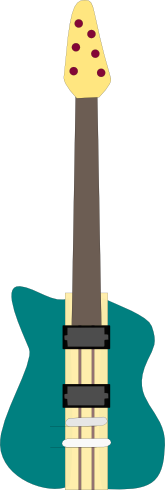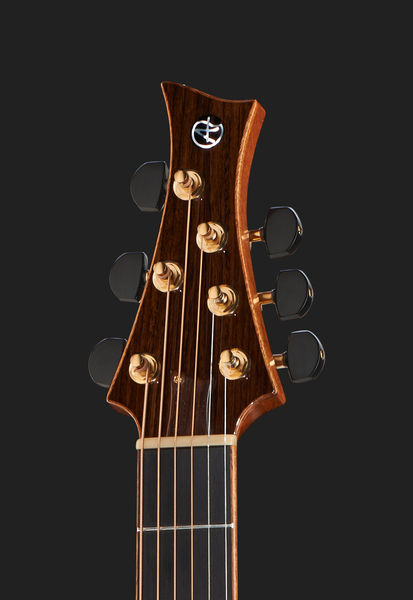
 |
|
#1
|
|||
|
|||
|
I'll be building a guitar soon, or half of one. Just bought a neck-through piece which comes already fretted so all the woodwork I have to do is fit body wings, carve the headstock, and a bit of routing.
It occurred to me that, since the tuners exert a considerable force on the headstock, it might be necessary to balance these out so the neck is pulled straight towards the bridge and there is no force created which will try to twist the neck. Or am I overthinking this? |
|
#2
|
|||
|
|||
|
Quote:
|
|
#3
|
|||
|
|||
|
Haven't decided. I've been messing around in a drawing program and came up with this...
 ..which is fairly symmetrical, but I haven't got to any final decision yet so I thought I'd better check now before I design something that isn't going to be viable. I guess the extra strength of a 5-piece laminated neck will help here. |
|
#4
|
|||
|
|||
|
I like shapes that let the strings run in a straight line across the nut and into the post - or at least very close to straight line.
Here's a somewhat extreme example from an acoustic guitar:  I might prefer having the more widely spaced tuners on the bottom side because it is harder to see them when tuning the guitar.
__________________
Breedlove, Landola, a couple of electrics, and a guitar-shaped-object |
|
#5
|
|||
|
|||
|
Quote:
are you going to tip the headstock back or lay it flat like a Fender? i wouldn't worry too much about the torque issue. as i said before string tension on an electric is lower. and as far a i know, only guild 12 strings and ric basses demonstrate any concern for rotational movement with their dual truss rod designs. as long as you don't make anything too thin and weak you should be fine. a multi-piece neck would be ok if this really bothers you. btw i have an 8 string ibanez that has a 5 pc neck, 2 titanium re-enforcment bars, and a truss rod. overkill? perhaps, but that guitar has a very wide and very shallow neck and 2 more bass strings. something to keep in mind when planning your design. |
|
#6
|
|||
|
|||
|
Interesting to know that such a small headstock (with 6 holes in it!) is still strong enough to take the strain. I like that shape and was thinking about something along those lines. Getting rid of the nut slot -> tuner string angle looks like a good idea for tuning.
|
|
#7
|
|||
|
|||
|
Quote:
Are there any rules of thumb for headstock size/mass eg smaller is better? If I had to guess, I'd guess that any effect on the sound of the guitar would be small - and probably quite unpredictable. Still it's always good to know of anything which increase your chances of getting the best out of the materials. |
|
#8
|
|||
|
|||
|
Quote:
Are there any rules of thumb for headstock size/mass eg smaller is better? If I had to guess, I'd guess that any effect on the sound of the guitar would be small - and probably quite unpredictable. Still it's always good to know of anything which increases your chances of getting the best out of the materials. |
|
#9
|
|||
|
|||
|
I think that very wide headstocks may actually cause more strain on the wood than narrow ones: more distance from the centerline and lateral forces.
Some, apparently knowledgeable, people seem to believe that lighter headstocks are good for sound. Something like that has been mentioned in threads about slotted headstocks. Probably, the effect is negligible.
__________________
Breedlove, Landola, a couple of electrics, and a guitar-shaped-object |
|
#10
|
|||
|
|||
|
"Are there any rules of thumb for headstock size/mass eg smaller is better? If I had to guess, I'd guess that any effect on the sound of the guitar would be small - and probably quite unpredictable."
Small; maybe. Unpredictable; certainly. You're building a solid body? I don't have as much experience with those as with acoustics, but that won't stop me from offering an opinion. On a solid body guitar the neck is the most flexible part. That means any 'neck' resonances can alter the tone, particularly if they happen in the range of the fundamentals of any of the string notes. Since the head is 'way out on the end of the diving board, so to speak, the mass of the headstock will have a big effect on the pitches and activity of the 'neck' resonances. I put neck in ellipses there because you're really talking about resonant modes of the whole guitar, which you can think of as if it's a long bar that is tapered, so that one end (the body) is much wider than the other. If you compare a tapered bar like that with a rectangular one, you'll find that the inactive 'node' lines of the resonant modes are all shifted down toward the wide end. On several good solid body guitars that I've checked, the lower node lines for the first few resonant modes (the ones that are within string range) tend to 'stack up' right around the bridge. This means that the bridge is not going to be moving much for any note you play, which is a good thing. There's no free lunch though: the upper node lines are shifted down the neck. Normally, on an acoustic, the upper node lines are pretty close to the nut, but on a solid body they can be several frets down. This means that the nut can be moving at 'string' frequencies, and it also puts the headstock further out from the node lines. Since you can think of a node as being like the pivot of a see-saw, having the node line up around the third fret is like lengthening that end of the see-saw; small changes in mass in the head make a bigger difference. Adding mass to the head does two things: it drops the pitches of any of those 'bar' modes, and it makes them harder to move. Sadly, there's no way to know in advance which of those two things you're going to want to do in a particular case. Good designs, like the Strat, have sort of worked that out so that things line up in a way that's not troublesome in most cases; there's always some variation due to the fact that the density and stiffness of wood vary. Nailing it in a one-off might be tricky. The thing that saves you is that the frequency match between a 'bar' resonance of the guitar itself and a played note has to be pretty exact for it to cause real problems. In the case of a guitar I strongly suspect (without having the data to prove it) that you have to be fretting the note on a part of the neck that's moving (between node lines) for it to be a problem. It's somewhat unlikely that you'll meet both conditions, so in general you don't have to worry about it. However, it's one of those things that can matter a lot when it matters at all. It's sort of like 007 tied in a chair, with the water rising: the depth is not important until it reaches his nose... SOOOOO.... what's the bottom line? Darned if I know. Making the head heavier makes any problem you have less problematic, because the neck is moving less. However, it might make it more likely that you'll have a problem, since it shifts more of those bar modes down into the range of pitches that cause problems. Without pretty sophisticated vibration modeling software, and a complete knowledge of the woods and other materials you're using, it's probably impossible to predict whether you'll have a problem in advance. OTOH, it's fairly easy once you've got the thing built to adjust things to control any issues that arise, at least in theory. I'll wrap up with a couple of general points. One is; now you know why solid body basses tend to have 'dead' notes: not only is the nut on a part of the thing that's moving, the bridge is too! They put the bridge 'way out at the lower end of the body to cut down on the length, which causes problems because now it's moving. The other is: stiffness. Solid body guitars have relatively long and skinny necks as compared with acoustics,which means the modes are more active and at lower frequencies than they 'could' be. Adding stiffness, particularly in the neck, makes the modes less active and raises the pitches, both of which can help. I'd invest in some carbon fiber. |
|
#11
|
|||
|
|||
|
Great post
 I had a feeling that there might not be any simple rules! Still, the more you understand the better. Some really useful information to think about - thanks. I had a feeling that there might not be any simple rules! Still, the more you understand the better. Some really useful information to think about - thanks.
|
|
#12
|
|||
|
|||
|
One design I have admired and you might consider is some variation on the Ernie Ball Musicman 4 +2. That gets you near to a straight line string pull.
|